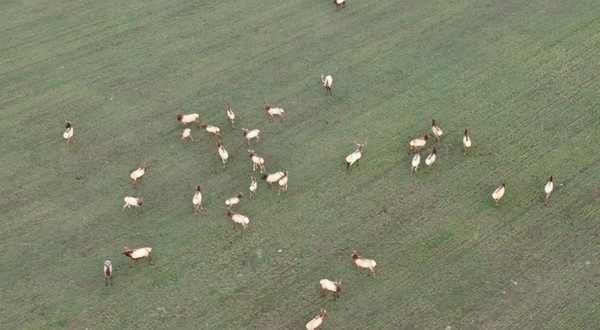
Photo courtesy of Arkansas Game and Fish Commission
Over the past two weeks, Arkansas Game and Fish Commission (AGFC) biologists have taken to the sky to evaluate the status of Arkansas’s elk herd. Preliminary results indicate the population is on the rise.
Wes Wright, elk program coordinator for the AGFC, says the initial tally of elk during the surveys was 419, a 5 percent increase from last year. He states “this is the first time in five years that we’ve seen an increase.
Elk tend to form large herds concentrated on specific habitat types during the late winter. This habit and their large size makes them easier to spot, offering counts much closer to the actual population size than can be performed for other species, such as white-tailed deer.
Wright says the upturn is welcome news after five years of decreases following measures taken with elk management following the detection of chronic wasting disease in the herd. In addition to the number of elk seen, biologists are evaluating the ratios of bull-to-cow elk and calves per cow seen.
Wright states historically AGFC sees about 40 bulls per 100 cows and the same ratio of calves to cows. One calf per two adult cows is pretty typical of other states with elk populations. He says Arkansas’s bull-to-cow ratio is a bit higher than many Western states traditionally known for elk hunting.
One of the objectives to the elk program is to provide a quality hunting experience. Wright says, “everyone wants to harvest a bull, and with the very limited draws and quotas we have in place, we’re able to regulate harvest very tightly to give hunters who draw a bull tag a very good chance at their bull on the limited amount of land available in our elk range.”
The AGFC has been conducting annual aerial surveys to monitor the population since 1991. The only years the flights were not conducted were 2014 and 2015, due to a lack of helicopter contractors available to pilot the survey.
When in the air, Wright always tries to have one observer for each side of the helicopter, one being himself and the other being another wildlife biologist on staff. In some cases, the pilot has to fill in to be an extra set of eyes. He states, “we’ll fly over the large wildlife openings created for the elk on public ground and take our time counting. We also will take pictures and video to double check our numbers later.”
Wright credits the herd’s continued healthy numbers to continued habitat enhancements in Arkansas’s elk country. He says areas like Richland Valley on Gene Rush Wildlife Management Area and Bearcat Hollow WMA near Jasper have exploded with elk since the initiation of large wildlife openings. Since habitat work in Richland Valley began, Wright says he’s seen as many as 300 elk in one morning at that location. Bearcat Hollow has shown similar success.
WebReadyTM Powered by WireReady® NSI










